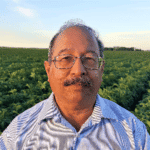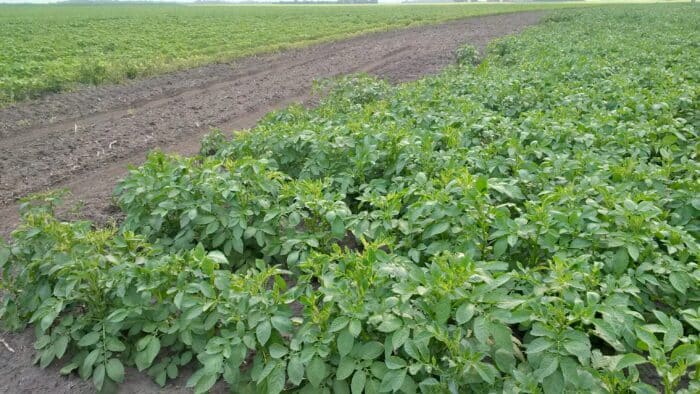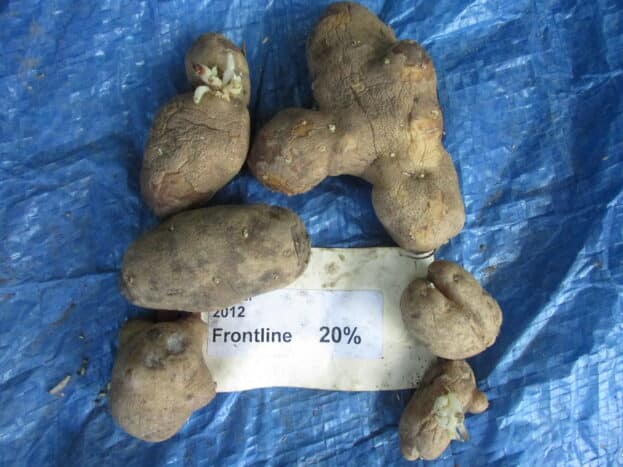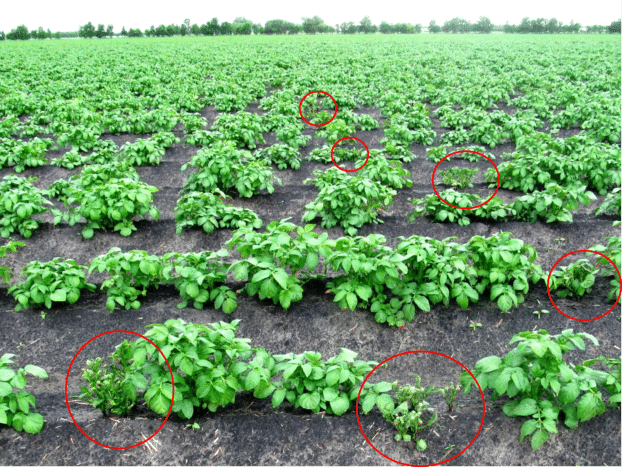How to identify if your spuds have herbicide injury and what to do once it’s confirmed.
Experts


Editor’s note: This interview has been edited for length and clarity.
Spud Smart (SS): Why is herbicide injury a concern for potato growers?
Vikram Bisht (VB): Non-target herbicide injury is a frequently occurring issue in many crops. Potatoes are particularly sensitive to many herbicides used in the crops surrounding potatoes.
There is a cost of herbicide injury to potatoes, which could be very negligible or be very severe losses. On commercial crops, the losses are in yield reduction and tuber quality. But on seed quality, the losses can be very significant due to possible rejection of the seed lots. And it could also become a problem for next year. There are possibilities of litigation resulting from severe herbicide injury losses, especially for seed growers.
SS: How does herbicide injury happen on potatoes?
VB: Herbicide injury is possible through various ways. Drift from the nearby applications under various conditions, which favour the spread of the applied material, whether it is too windy, there is no air movement. Improper nozzles have been used for the conditions making very fine mist, air temperature inversions can be an issue and proximity to the sensitive crops.

Improperly cleaned sprayer tanks can be an issue in many cases, misapplications of product in a field or a wrong product in a field — this happens quite often. Mistimed application of herbicides when, for example, the applicator sprays when the plants are already emerging or there are ground crack from emerging sprouts.
Also, soil residue is a big issue in some cases, and important to understand how it happens. Sensitive varieties to already registered products on potatoes are an issue that happens sometimes.
SS: How do you identify that a potato plant has been injured by an herbicide?
VB: One of the important things is for people to become familiar with the foliar symptoms of commonly used herbicides in your area…it is also helpful to understand what is the distribution pattern. If the symptoms of the injury are fading away from the edge of the field, it is possible that there’s drift associated. There may be other ways to understand how the drift happened. The affected plants are randomly distributed in a field it is possibly a seed carryover. And often the concentration in zones could be a soil issue.
Now, there are some cases where there is no visible injury. This may happen when the herbicide that has come onto the crop is at very, very low concentrations or late in season. There are cases, where for example, glyphosate has been used on some field crops for weed control, that is pre-harvest dry down, there is a late season exposure. Unfortunately, in many cases, the injury to the seed lot is not detected by the post-harvest testing that is done for viruses in the labs. And so, one of the important things if there is suspicion that there may have been some herbicide injury on to the seed crop, it is good to get a grow out test — that is where you will possibly catch some of the herbicide injury issues.

Andy Robinson (AB): Typically, you’re going to visually see injury in the leaves. Sometimes you might see injury in the tubers, sometimes you won’t. It depends on the environment, the timing, and the product that comes in contact with the plant. There are many things you should look at to diagnosis herbicide injury, including field pattern, plant symptoms, and areas adjacent to the field
If you’re not comfortable with making the diagnosis, get in touch with somebody that can help. This is a critical step to avoid misdiagnosis. Call your agronomist, or extension personnel, or whoever might be available to help you out that has expertise in herbicide injury.
SS: What are the different types of herbicide injury?
AR: For the growth regulators or group 4’s, you’re going to see what we often refer to as epinasty, and that is kind of this twisting, curling, bubbling, wrinkling of the stems, leaf’s, leaflets. Sometimes you may see parallel venation in the leaflets where the veins instead of going away from that mid rib vein, kind of more almost line up with the mid rib vein.
What happens to the tubers? For 2,4-D injury you may see increased tuber set, smaller tubers, and deeper eyes. These symptoms can be especially pronounced in Russet varieties. As far as carryover of 2,4-D in seed, this hasn’t been found.
Dicamba is a little bit different compound. It’s becoming more and more of an issue because of the increasing amount of acres that dicamba is sprayed on during the growing season over dicamba-resistant crops. Dicamba causes similar epinasty symptoms to 2,4-D, but symptoms usually will be more severe.

In addition to 2,4-D symptoms, dicamba can cause a fiddle neck appearance at the top of the leaflets. At times, when the dicamba amount is so high it will completely inhibit the growth of new leaves. As you go from 2,4-D to dicamba, and then you get into some of the group 4 herbicides with longer residuals, such as clopyralid, picloram, triclopyr. Symptoms from these herbicides are worse than dicamba and have a greater longevity. Tubers can become malformed, pear shaped, elongated, etc. when plants are exposed during early- to mid-bulking.
Glyphosate will translocate to the growing points, the newest leaves and also down the tubers and roots. This is why the yellowing on the leaflets and the leaves are seen. Glyphosate will also stunt the plant growth and reduce overall production. Smaller leaves and shorter internodes have been observed. Tubers can become ugly and malformed, especially if glyphosate exposure occurs in the early- to mid-bulking stages.
SS: How do you protect your potatoes against herbicide injury?
VB: I suggest that people maintain proper pesticide application logs. In case of litigations, these spray logs are basically required if you’re going through litigation, or you want to protect yourself. Inform the neighbours, talk to them that you have a sensitive crop close to theirs and also be aware of what are the neighbouring crops, and it could help in the avoidance of the problem.

What can be done if there is a seed carryover that is suspected? One of the first things is to take photos and inform the certification officials, crop consultants if you have any, and also the seed seller. Because they need to know that there has been a possible suspicion here, it is important to take the samples as soon as possible and get them analyzed for herbicide residues. With delay the herbicide residues may get diluted in a growing plant. Unfortunately, in many cases, the resolution for detection is often higher than the levels which may still be producing symptoms in the field.
AR: Something very important I think growers need to remember is when you do find it, or somebody sees, a scout or whoever it is in the field, it’s really important to document it right away… if you have a governmental agency that will come and investigate too that can also be very important. As for me as an extension specialist, my job is to educate so I help growers understand what’s going on and what the problem is, but I have no authority to enforce any laws or rules.
It’s important to note these symptoms, to contact the proper channels if needed, if something major is happening, because usually potatoes when there’s injury, there’s a lot of money involved. And the reason why you document and sample right away is because over time those injury symptoms they will lessen, you’ll get new leaves sometimes grow over and symptoms might disappear as herbicide amounts lessen as plants break it down, and then suddenly it is difficult to find the injury. Waiting a longer time will make it difficult to find herbicide residues in laboratory testing.
Sponsored by: 
Related Articles
Herbicide Injury on Potatoes — A Spud Smart Roundtable Webinar & Podcast








